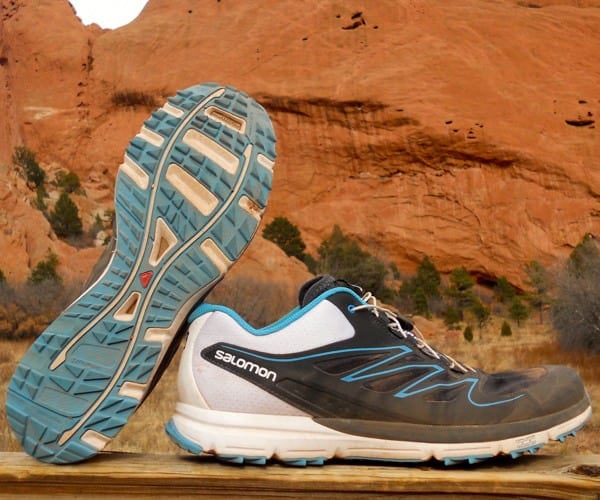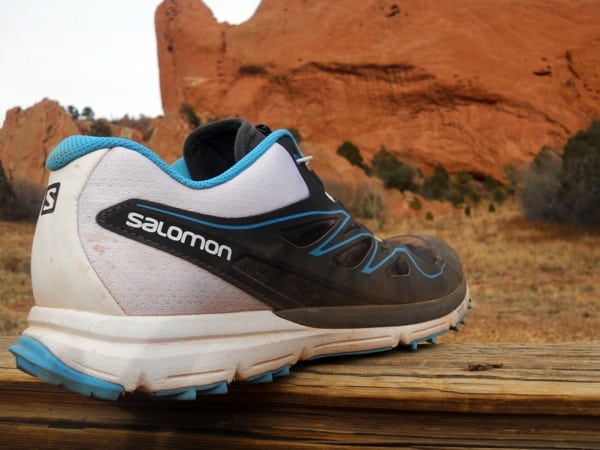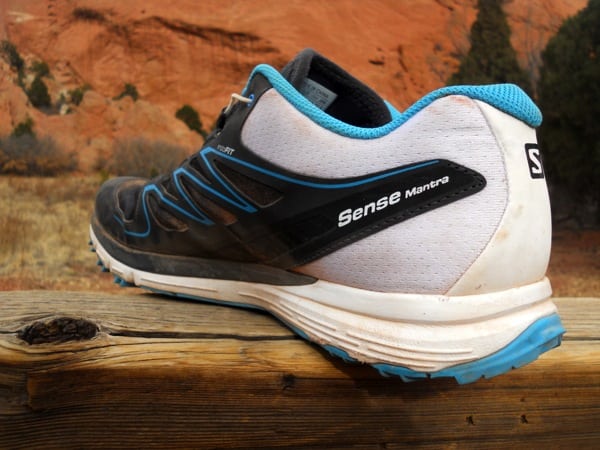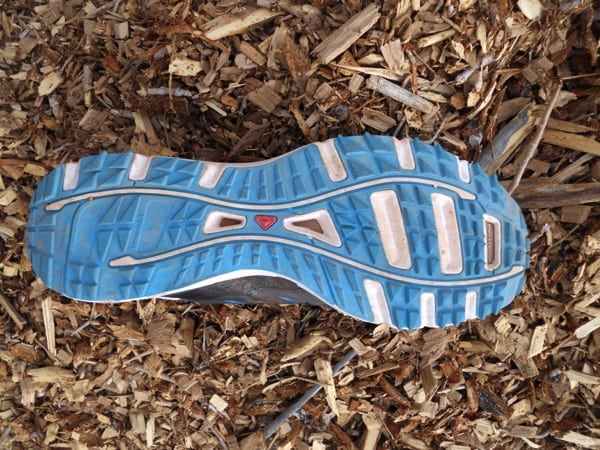Our Favorite Trail Running Shoes
Check out our Best Trail Running Shoes article to learn about our current favorite trail running shoes!
Salomon Sense Mantra Review
The trends in trail running shoes seem to have shifted back towards a healthier middle ground after several years of shoe designs leaning towards the polar minimalist side of things. I’ve talked to many runners on the trail who have told me that after years of wearing minimal shoes, they’re now purchasing trail shoes with a bit more protection and cushioning that still retain a lightweight and agile feel. I have never been more excited about trail shoes than what has been hitting the market for Spring ’13, as most companies have released shoes that are lightweight, have lower drops, and a good amount of cushioning. With that in mind, I decided to showcase the Salomon Sense Mantra ($120) as a perfect example of a shoe company finding a middle ground between minimalism and battleship shoes.

The Salomon Sense Mantra.
Upper
The first thing I noticed about the Sense Mantra was the coordination of open mesh that blended into the overlays and rand of the shoe. The forward two-thirds of the Mantra works essentially like a single piece where durable and very breathable mesh is reinforced by a synthetic leather material which is sewn on and very durable. Furthermore, the toe rand is reinforced in typical Salomon fashion by a barely there rubber compound which helps protect the toes and maintains the shape of the toe box.
A thin and breathable tongue composed of nylon and lycra offers just enough protection from the pressure of Kevlar laces, and the tongue is gusseted nicely throughout the midfoot. A soft heel collar and rather low heel worried me at first, but after a few miles I hardly noticed the illusion that my heel was slipping. I’ve found this to occur with all Salomon shoes I own and it has never been a problem. Aesthetically, the white heel portion of my Mantra kept bringing back passages from one of my favorite running biographies, Murray Halberg’s A Clean Pair of Heels. There is something about white heels that just look fast.
I should note that the only Salomon trail shoes I’ve spent a substantial amount of time wearing are the Speedcross 2 and 3, and I never felt like the forefoot was wide enough for longer races or runs over three hours due to my feet swelling. Thankfully, Salomon constructed a wider forefoot on the Mantra which tapers into a slender mid foot and heel. Although an overused descriptor in the world of shoe reviews, the Mantra does have a slipper-like feel.

The Mantra’s lateral upper.
Midsole
With a 6mm heel-toe drop, the Mantra is like a kinder, gentler version of the of the S-Lab Sense. With a 21mm to 15 mm differential rather than the Sense’s 13mm to 9mm, the Mantra has nearly double the midsole cushioning yet maintains a minimal feel. At just under 10 ounces for my US men’s 9.5, the Mantra feels a great deal more nimble and agile than other trail shoes I own that weigh the same. I attribute this to a very simple and effective design where really nothing gets in the way of your foot responding to the terrain.
Designed for “natural running,” the front half of the Mantra features a softer EVA foam on top of a denser midsole foam. The sweet spot for foot striking is definitely the mid to forefoot and the Mantra is made for a faster cadence. Profeel Film is a very thin piece of carbon fiber that functions as a simple and effective rock plate. Frankly, I am surprised at the kind of technical terrain the Mantra can handle without any damage to my feet.

The Sense Mantra’s medial upper.
Outsole
The Contagrip outsole handled everything I could throw at it from packed snow, sand, and mud to the hard slickrock of the Utah desert. Lugs are small and multi-directional to provide traction on ascents and descents, and I felt like the small height of the lugs allowed a bit of travel and slide on steep downhills without feeling out of control. After more than 200 miles in my Mantras, the outsole shows almost no wear which is pretty incredible.

The Sense Mantra’s outsole.
Overall Impression
Without a doubt the Sense Mantra is one of the most well-constructed trail shoes I’ve ever worn. The upper is simple, lightweight and durable, and the fit feels minimal even though this is a protective shoe. The Quicklace system integrates flawlessly into the rest of the upper without any unnecessary aesthetics or gadgetry, and the midsole seems to retain its resiliency.
To really test out the Mantra I headed to Moab for the Red Hot 55k. I felt that the mixture of dirt road, clay, sand, and tons of cambered slickrock would put any trail shoe through the paces. I felt that the Mantra not only held up well for the 33+ mile distance, but came away from the race nearly unscathed, a tip of the hat to its durability. The cambered slickrock wreaked havoc on mine and everyone else’s ankles, but the Mantra hugged my foot, keeping my toes and skin blister-free. Very little sand and debris were present in my shoe after the full distance, and I felt like I was able to tackle technical sections with confidence.
I would recommend the Mantra as a trainer and over-50-mile racer for minimalist runners looking for a bit more protection. I also think it would make a great speedier shoe for runners who love protective shoes but might be looking for a trail shoe for shorter and more technical courses.
[Editor’s Note: We carry the Salomon Sense Mantra in the iRunFar Store; however, the reviewer independently chose, tested, and reviewed the shoes.]
